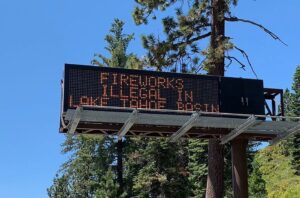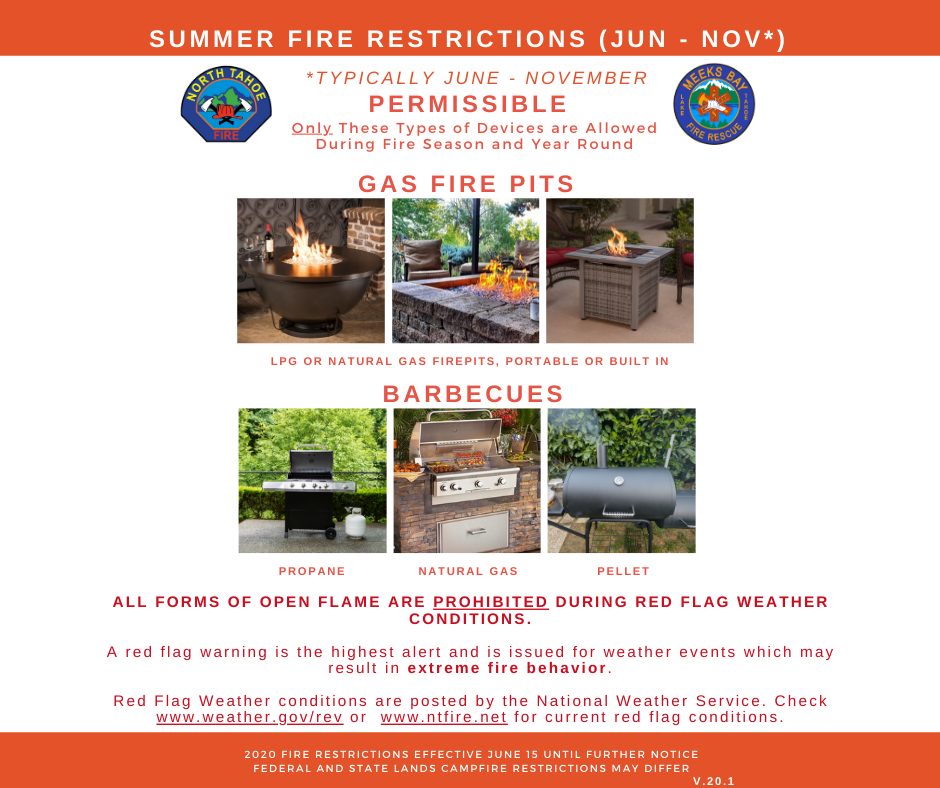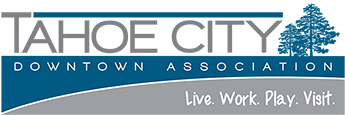 Unfortunately, COVID has canceled our annual 4th of July Fireworks Show. As a result, we need to adapt and find other ways to celebrate the day that do NOT include fire. We want to remind visitors and residents that wildfires pose a serious threat to Tahoe neighborhoods and communities. Whether camping, hiking or participating in some other activity in the forest, keep in mind the following advice to Keep Tahoe Fire Safe.
Unfortunately, COVID has canceled our annual 4th of July Fireworks Show. As a result, we need to adapt and find other ways to celebrate the day that do NOT include fire. We want to remind visitors and residents that wildfires pose a serious threat to Tahoe neighborhoods and communities. Whether camping, hiking or participating in some other activity in the forest, keep in mind the following advice to Keep Tahoe Fire Safe.
Fire restrictions are in effect. Wood burning and charcoal burning appliances are BANNED until fire season is over. Fireworks are illegal in the Tahoe basin, please practice fire safety!
Fireworks
The Fourth of July holiday is right around the corner. All fireworks including sparklers and firecrackers are illegal in the Tahoe Basin because of the wildfire danger they pose to our forests. Please don’t bring any fireworks to Lake Tahoe!
Campfires
Sadly, illegal campfires continue to be the cause more than 90 percent of all wildfires at Lake Tahoe.
- Campfires and portable charcoal grills are only allowed within metal fire rings and/or standup grills provided in designated campgrounds.
- Campfires and portable charcoal grills are not allowed on National Forest beaches, in Desolation Wilderness, Meiss Country, along Genoa Peak Road and the Tahoe Rim Trail, or in the general forest.
- Gas or propane stoves are allowed in all areas with a free, valid California Campfire Permit available at any Forest Service office.
In addition, during periods of high fire danger, campfires in designated areas may be restricted. Before building a campfire, be sure to check with local fire districts or the Forest Service office to find out if restrictions are in place.
A safe fire
Learn to properly build, maintain and extinguish campfires and always keep a bucket of water and a shovel nearby.
- Select an open location away from trees and overhanging tree branches, logs, brush or dry vegetation.
- Keep the fire small and be sure that all logs fit within the fire ring.
- Never leave the campfire unattended and completely extinguish it using the Soak, Stir and Feel method before leaving.
- Soak the fire with water and stir thoroughly.
- Using the back of your hand, feel for any remaining heat.
- Repeat as needed until the fire is completely extinguished and no hotspots remain.
Sparks
Did you know that 95 percent of all wildfires are caused by human activity? Things like lawn equipment, debris burning, target shooting and vehicles can all cause sparks that may ignite a wildfire when used under the wrong conditions.
Lawn mowers, weed-eaters, chain saws, grinders, welders, tractors and trimmers can all spark a wildland fire when used during hot, dry and windy weather. This type of equipment should be operated before 10 a.m. when the humidity is higher and never when it’s excessively dry, hot and/or windy.
Vehicles should be properly maintained with nothing dragging on the ground. Dragging chains or any other type of metal can cause sparks that may ignite a wildfire. Practice proper towing by using appropriate safety devices and hitches that secure chains or other equipment. Don’t drive or park vehicles on dry vegetation. Hot exhaust pipes, mufflers and catalytic converters may ignite grasses and other vegetation. Properly maintain brakes and tires. Exposed wheel rims and brakes worn too thin can cause sparks.
Burning
Residential burning is only allowed under specific conditions and in certain areas with a valid permit. Check with your local fire district to determine if burning is allowed in your area and if restrictions are in place.
Target shooting
Target shooting under hot, dry conditions can spark a fire. When target shooting, be sure to choose an area free of dry vegetation and avoid shooting on hot, windy days. Use proper targets, such as clay pigeons and avoid shooting at metal targets or rocks.
The Tahoe Fire and Fuels Team consists of representatives of Tahoe Basin fire agencies, CAL FIRE, Nevada Division of Forestry and related state agencies, University of California and Nevada Cooperative Extensions, the Tahoe Regional Planning Agency, the U.S. Forest Service, conservation districts from both states, the California Tahoe Conservancy and the Lahontan Regional Water Quality Control Board. Our Mission is to protect lives, property and the environment within the Lake Tahoe Basin from wildfire by implementing prioritized fuels reduction projects and engaging the public in becoming a Fire Adapted Community.

Content shared from North Tahoe Fire and the Tahoe Weekly.
